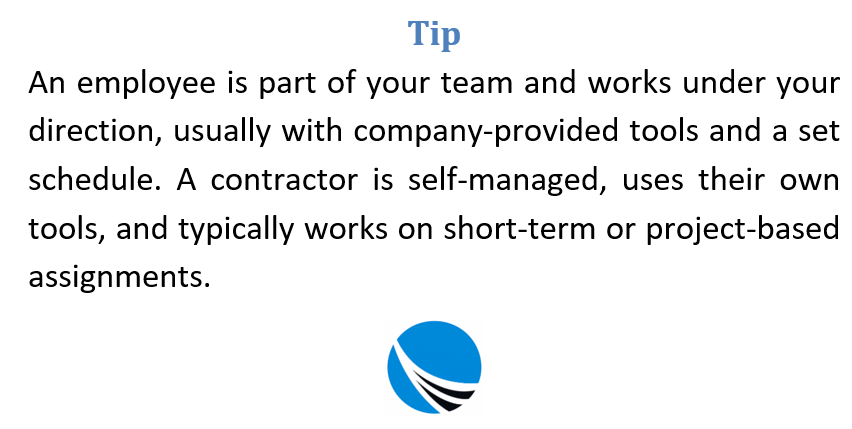As a business owner, deciding whether to bring on an employee or a contractor is a choice that directly affects your budget, flexibility, and even legal responsibilities. Each has distinct advantages and challenges, and the ideal choice often depends on your operational needs, the kind of work you require, and how much oversight you want to maintain. This guide explores the core differences, benefits, and drawbacks of both employment models to help you make a well-informed decision.

Understanding the Difference
Employees are individuals hired to be part of your business’s regular team. They usually work under your supervision, follow set schedules, and use company tools or systems. In contrast, independent contractors work on a temporary or project basis. They operate under their own business names, provide their own tools, and determine their own schedules.
While the surface-level distinctions seem straightforward, the legal classification can get murky. Authorities such as the IRS focus heavily on the degree of control a business has over a worker. If you’re directing how, when, and where the work is done, you might be looking at an employee relationship, not a contractor setup.
Some practical indicators include:
- Work location: Employees often work on-site; contractors usually choose their own workspace.
- Tools and resources: Employees rely on company-provided tools; contractors bring their own.
- Schedule control: Employers set employee schedules; contractors manage their own time.
- Compensation: Contractors are typically paid per project or milestone, not by the hour, and don’t receive benefits or tax withholdings from the business.
It’s essential to classify correctly to avoid potential fines or legal penalties.
When Hiring Employees Makes Sense
Hiring an employee means you’re adding someone who will likely become part of the company’s fabric. They bring stability, can grow with your organization, and contribute to long-term goals. Here are some key reasons to opt for employees:
Long-Term Integration
Employees are more likely to develop a deep understanding of your company’s values, mission, and operations. With time, they become ingrained in the day-to-day rhythm and are more likely to be committed to your company’s long-term success.
Flexibility in Role Expansion
Because employees are under your direct control, you can shift their responsibilities as needs change. Whether it’s adjusting to new priorities or expanding a role, employees allow for dynamic allocation of tasks.
Team Cohesion
Having full-time staff fosters a stronger company culture. Employees are more inclined to participate in team-building activities, internal training, and company initiatives, which supports collaboration and unity.
Consistent Performance
You can count on employees to be available during set hours, contributing to predictable workflows and output. There’s no need to repeatedly onboard new individuals for recurring needs.
Potential Drawbacks of Employees
Of course, taking on an employee comes with commitments and obligations that can be challenging for smaller businesses.
Costly Benefits and Legal Obligations
Employers are responsible for a range of expenses, including wages, taxes, and often benefits like healthcare and retirement plans. Additionally, you’re bound by employment laws, such as overtime regulations, anti-discrimination requirements, and workplace safety rules.
Responsibility for Growth and Development
Employees typically expect growth opportunities. To retain top talent, you’ll need to invest in training, mentorship, and clear career progression paths, which require time and resources.
Increased Administrative Tasks
From processing payroll to tracking vacation time and handling legal compliance, managing employees involves far more administrative work than working with contractors.
Why You Might Choose Contractors
Independent contractors can be a smart option for businesses that need specific skills for short-term projects or want to stay lean.
Specialized Expertise
Contractors often possess high-level skills and niche experience. They come ready to work with minimal training, making them ideal for one-off assignments that require specialized knowledge.
Cost Efficiency
While contractor rates may seem higher upfront, you avoid paying employment taxes, benefits, and other overhead costs. Contractors also handle their own insurance and retirement plans.
Project-Based Flexibility
If your business has fluctuating needs or seasonal spikes, contractors allow you to scale quickly without making long-term commitments. Once the work is done, the agreement ends, with no additional obligations.
Reduced Supervision
Contractors are usually self-managing. They decide how to complete the task and are responsible for meeting deadlines. This hands-off approach frees up internal management capacity.

Downsides of Hiring Contractors
Despite the flexibility they offer, contractors can introduce certain challenges.
Limited Connection to Your Business
Because contractors are not embedded in your team, they may lack a deep understanding of your brand or objectives. This can be a disadvantage for roles involving customer interaction or brand representation.
Potential for Inconsistency
Different contractors come with varying work styles and levels of commitment. If you frequently bring in new people, quality and output may vary, and you may find yourself constantly evaluating new talent.
Unpredictable Availability
Since contractors juggle multiple clients, their schedules may not align with your timelines. They can also leave at short notice, which might disrupt your workflow if you depend heavily on them.
Legal Boundaries
Contractors aren’t automatically bound by company policies, including confidentiality. If sensitive information is involved, you should consider a clear written agreement or NDA to safeguard your business.
Blended Hiring Models
Many modern businesses find that using a mix of employees and contractors offers the best of both worlds. Employees provide stability and long-term growth, while contractors allow for agility and cost-effective scaling.
For example:
- Use employees for core roles such as operations, sales, and customer service.
- Bring in contractors for specialized tasks like graphic design, software development, or accounting.
This hybrid model can help you stay competitive, nimble, and responsive to changing demands.
Key Considerations Before Hiring
Before choosing between a contractor and an employee, reflect on these key questions:
- Will this role be ongoing or project-based?
- Do I need this person to represent or embody my company brand?
- Can I afford the costs associated with a full-time employee?
- How much oversight and direction will this role require?
- Do I want this individual to grow within the organization?
Answering these questions can help you clarify the ideal type of worker for your needs.
Final Thoughts
Deciding between hiring an employee or working with a contractor is more than just a budgeting decision. It’s a strategic move that can influence your business’s productivity, flexibility, and culture. Employees offer long-term loyalty, integration, and control. Contractors bring expertise, independence, and flexibility.
Understanding the nature of the job and the kind of relationship you need is crucial. For best results, consult a legal or HR advisor before finalizing the classification. By aligning your hiring strategy with your business goals, you’ll be better equipped to build a workforce that supports your long-term success.
Frequently Asked Questions
Why would a business hire a full-time employee?
Hiring an employee is ideal when you need someone committed long-term, who can grow with your company, adapt to shifting priorities, and contribute to building a strong team culture.
What makes contractors appealing to businesses?
Contractors bring specialized skills, don’t require benefits or tax contributions from the business, and offer flexibility for short-term projects—making them cost-effective and low-commitment.
Are contractors always cheaper than employees?
Not necessarily. While you save on benefits and payroll taxes, experienced contractors often charge higher rates because they cover their own taxes, insurance, and retirement planning.
What are the risks of misclassifying a worker?
Getting the classification wrong can lead to fines, back taxes, and legal trouble. If authorities determine a contractor should’ve been an employee, the employer may owe unpaid benefits and tax penalties.
Can a mix of employees and contractors work?
Absolutely. Many businesses use employees for core roles and contractors for specialized or short-term needs. This hybrid approach offers stability while keeping operations flexible and scalable.

